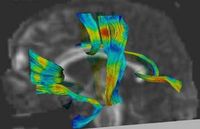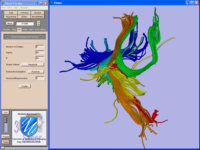Algorithm:MIT:New
Contents
- 1 Shape- and Atlas-Based Segmentation
- 2 DTI Analysis and Visualization
- 2.1 Tissue Classification
- 2.2 Boundary Localization
- 2.3 Registration Regularization
- 2.4 DTI Fiber Clustering/Atlas Creation/Analysis
- 2.5 Fiber Tract Modeling, Clustering and Quantitative Analysis
- 2.6 DTI-based Segmentation
- 2.7 Fiber-Tract-Bundle-based Non-Linear Registration
- 2.8 Stochastic Tractography
- 3 fMRI Detection and Analysis
- 4 Population Analysis of Anatomical Variability
- 5 Groupwise Registration
- 6 Collaborations with other groups in NAMIC
Shape- and Atlas-Based Segmentation
The goal of this project is to augment the segmentation process with prior information on the shape of the anatomical structures (shape atlas) learned from previously segmented scans (using, for example, Principal Component Analysis). We are working on methods that integrate the shape atlases with segmentation algorithms.
|
Tissue ClassificationThis type of algorithms assigns a tissue type to each voxel in the volume. Incorporating prior shape information biases the label assignment towards contiguous regions that are consistent with the shape model. More... New: K.M. Pohl, J. Fisher, S. Bouix, M. Shenton, R. W. McCarley, W.E.L. Grimson, R. Kikinis, and W.M. Wells. Using the Logarithm of Odds to Define a Vector Space on Probabilistic Atlases. Accapted to the Special Issue of Best Selected Papers from MICCAI 06 in Medical Image Analysis More... New: K.M. Pohl, R. Kikinis, and W.M. Wells. Active Mean Fields: Solving the Mean Field Approximation in the Level Set Framework. Accapted to IPMI 2007. More... Description - Publications - Software - AHM 2006 - AHM 2007 | |||||||||
Boundary LocalizationThis class of algorithms explicitly manipulates the representation of the object boundary to fit the strong gradients in the image, indicative of the object outline. Bias in the boundary evolution towards the likely shapes improves the robustness of the segmentation results when the intensity information alone is insufficient for boundary detection. More... | |||||||||
Registration RegularizationWe are interested in the effects of registration regularization on segmentation accuracy in joint registration-segmentation. More... New: Submission for MICCAI 2007 | |||||||||
DTI Analysis and VisualizationOur work in DTI analysis focuses on identifying new ways to provide an interpretation of the white matter connectivity and to utilize the information contained in the DTI images to create more comperehsive models of the brain architecture. atlases with segmentation algorithms.
|




